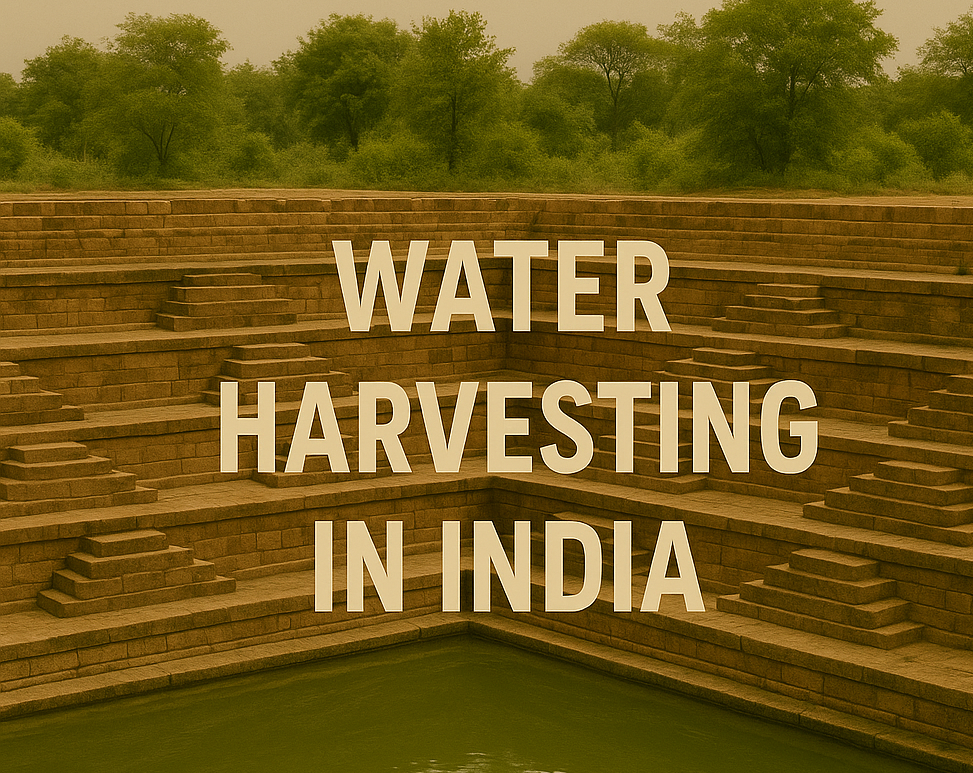Water Harvesting in India has always been at the core of the country’s survival and growth. From the stepwells of Gujarat to the temple tanks of Tamil Nadu, communities have relied on innovative ways to capture and store rainwater for centuries. These systems were not just functional, they represented a culture of sustainability and harmony with nature.
In today’s context of urbanization, population pressure, and climate change, water harvesting is no longer only a traditional practice. It has become a modern necessity, essential for conserving groundwater, supporting agriculture, and securing reliable water supplies for households and industries across India.
What is Water Harvesting?
Water harvesting is the process of collecting and storing rainwater or runoff for future use. It includes:
- Rainwater harvesting – collecting rain from rooftops, open areas, or catchments.
- Surface water harvesting – diverting and storing water from rivers, streams, or lakes.
- Groundwater recharge – allowing harvested water to percolate and refill aquifers.
Types of Water Harvesting in India
1.Top Rainwater Harvesting (Urban Areas)
- Collects rainwater from rooftops through pipes into storage tanks or recharge sysytem
- Helps reduce dependence on municipal supply and prevents waterlogging.
- Adopted in cities like Chennai, Bengaluru, and Delhi where water demand is high.
2. Community Tanks & Reservoirs (Rural India)
- Traditional village tanks, ponds, and lakes used for irrigation and drinking water.
3. Check Dams & Percolation Ponds
- Small barriers built across streams to slow down water flow and increase infiltration.
- Popular in semi-arid regions to recharge groundwater.
4. Farm Ponds & Percolation Pits
- Small ponds or pits dug in agricultural fields to store excess rainwater.
- Improve soil moisture and support crop growth in dry months.
5. Rooftop + Groundwater Recharge
- A dual system where rooftop water is directed into recharge wells.
- Widely promoted under government schemes for sustainable aquifer replenishment.
How to Overcome Water Scarcity in India
Water scarcity in India is no longer a distant threat—it is a present-day reality. With a rapidly growing population, erratic rainfall patterns, over-extraction of groundwater, and rising demand from agriculture, industries, and cities, the country faces increasing stress on its water resources. To ensure a sustainable future, India needs both traditional wisdom and modern solutions.
1. Promote Rainwater Harvesting
- Make rooftop rainwater harvesting mandatory in urban and rural areas.
- Revive traditional systems like baolis (stepwells), johads, and temple tanks.
- Encourage households, schools, and offices to store rainwater for domestic and irrigation use.
2. Strengthen Groundwater Recharge
- Construct recharge pits, percolation tanks, and check dams in drought-prone regions.
- Restore wetlands and ponds to allow natural percolation.
- Encourage farmers to adopt recharge-friendly irrigation methods.
3. Adopt Water-Efficient Agriculture
- Promote drip and sprinkler irrigation to reduce wastage.
- Shift from water-intensive crops (like paddy and sugarcane) to region-appropriate alternatives.
- Use soil-moisture sensors and modern agri-tech to optimize water use.
4. Improve Urban Water Management
- Upgrade drainage and water supply infrastructure in cities.
- Reduce leakage in municipal water pipelines.
- Promote wastewater recycling for non-drinking purposes like gardening, cooling, and construction.
5. Industrial Water Recycling
- Enforce zero-liquid discharge policies in major industries.
- Encourage reuse of treated effluents in cooling towers and manufacturing.
6. Community Participation & Awareness
- Involve local communities in water conservation projects.
- Launch awareness campaigns on water saving in daily life.
- Strengthen Panchayat-level water governance for village-level solutions.
7. Government Policies & Implementation
- Enforce strict groundwater extraction laws.
- Provide incentives for water-saving technologies.
- Implement large-scale river interlinking and watershed management projects in water-stressed regions.
Conclusion
Overcoming water scarcity in India requires a multi-pronged approach combining ancient practices like rainwater harvesting with modern technologies like drip irrigation and wastewater recycling. By making water management a shared responsibility between the government, industries, farmers, and citizens, India can secure its water future and ensure sustainable growth.


